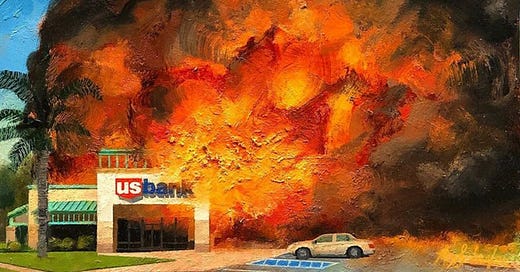When I was in high school I had the opportunity to intern at the Gordon Parks Foundation in Pleasantville, NY. Gordon Parks was extremely prolific as an artist, an activist, a writer, a director, a musician, and just about anything else you can think of. During my time at the foundation, I immersed myself in his extensive oeuvre, from his iconic photographs documenting the civil rights movement to his groundbreaking films like The Learning Tree and Shaft. What struck me most was the way Parks positioned art as a tool for activism, using his creativity not just to capture the world as it was but to challenge injustices as they were occurring. His work taught me that art is not only a reflection of life but also a means to actively reshape it—a philosophy that continues to inform my own approach to art and cultural preservation.
I picked up a camera because it was my choice of weapons against what I hated most about the universe: racism, intolerance, poverty. — Gordon Parks
Alexander Schaefer (b. 1969) @paintwithalex
Using his art as a weapon against injustice, Schaefer is a contemporary American painter known for his politically charged works confronting issues of economic inequality and institutional power.
In a world increasingly defined by precarity, economic instability, environmental collapse, and social fragmentation, art has the power to confront the chaos and channel our collective fears into action. I have recently come across the works of Alexander Schaefer and feel that he exemplifies this potential to a tee, using his politically charged paintings as a form of protest against the inequalities and corruption entrenched in modern systems. His series "Banks in Flames" does more than critique financial institutions; it challenges viewers to reckon with the fragility of the structures we rely on. Through bold imagery and public defiance, Schaefer’s work acts as a mirror to societal collapse. Simultaneously, his work acts as a catalyst for imagining something new. His choice of imagery is not just an indictment of corporate greed; it’s an invitation for us to imagine what could rise from the ashes. In these uncertain times, we need more artists like Schaefer—artists who dare to speak truth to power and remind us that art can be both a refuge and a weapon.
He gained widespread attention in 2011 with his “Banks in Flames” series, where he painted major financial institutions set ablaze. His art often explores the intersections of capitalism, social justice, and protest. Schaefer is also active in street art and en-plein-air painting, using public spaces to challenge dominant power structures through his work. His plein air practice—a nod to Impressionist traditions—brings a visceral energy to his scenes, grounding his critique of corporate greed in real-world locations. By painting directly in public spaces, Schaefer transforms everyday settings into stages for protest, democratizing the experience of his art.
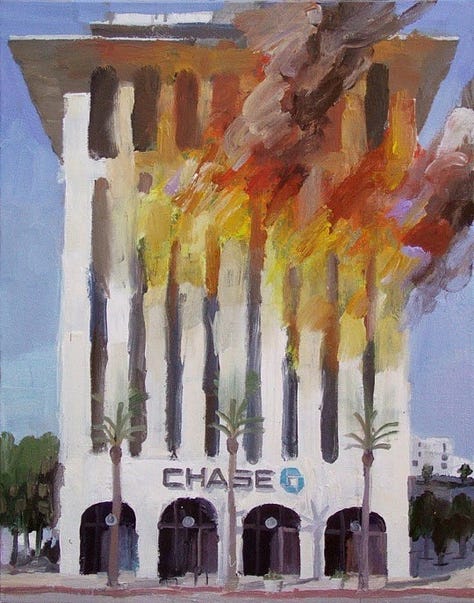
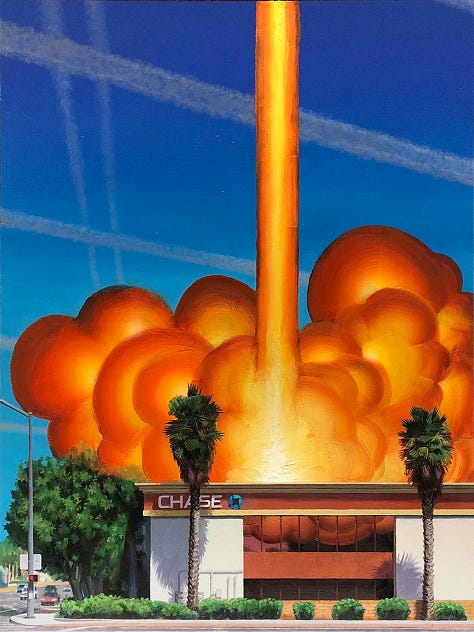
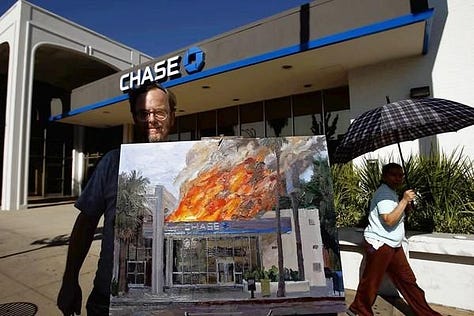
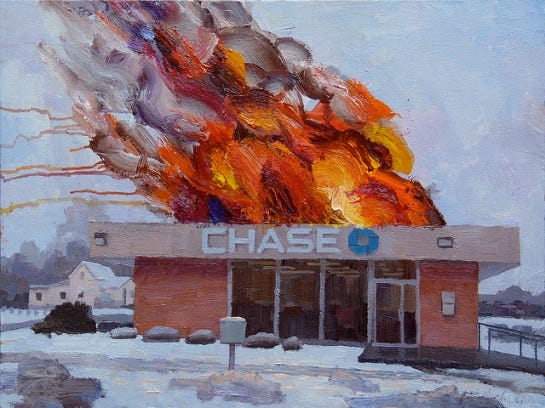
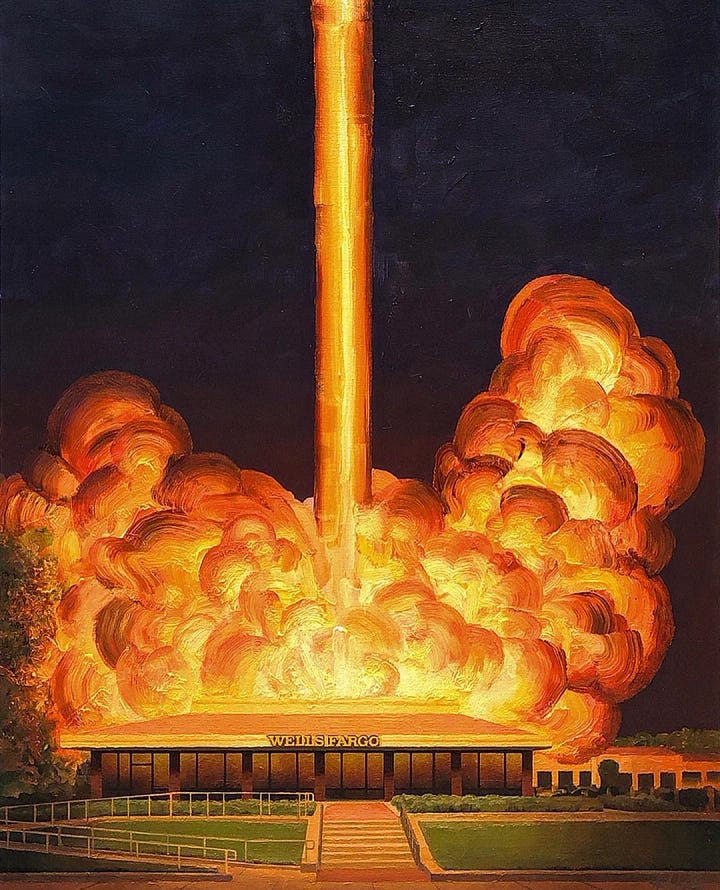
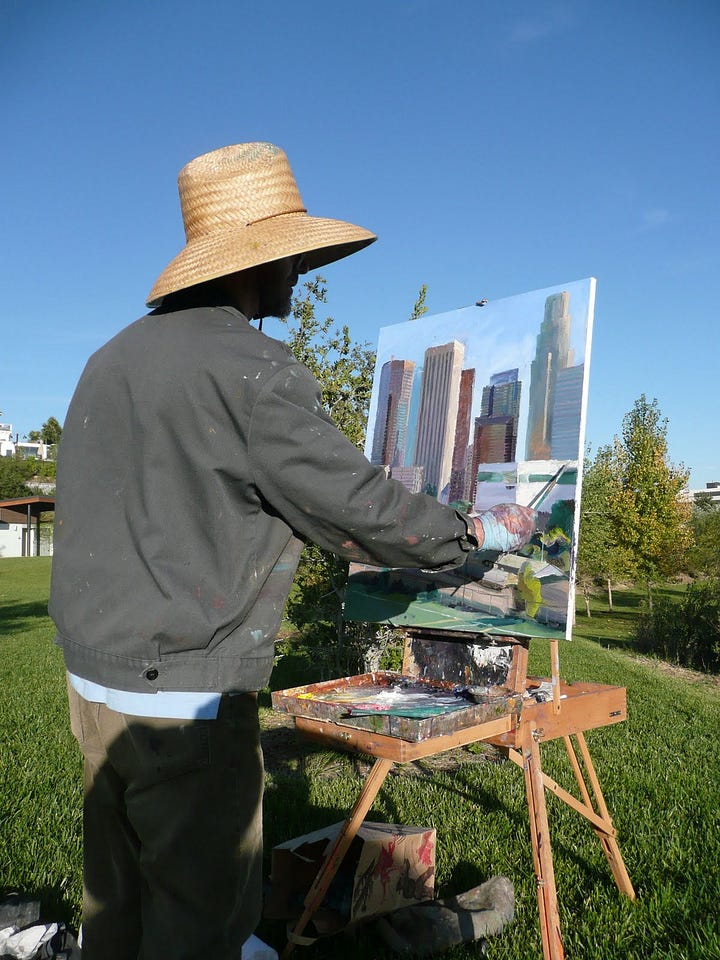

Schaefer has found himself embroiled in controversy due to the incendiary nature of his work. His paintings of burning banks have been seen by some as inciting violence, even leading to police questioning after he was spotted painting one of these images in public.1 Despite this, Schaefer insists that his work is a symbolic critique of corporate greed and corruption rather than a literal call to action.
His “Banks in Flames” series is a visceral critique of the financial system and its role in perpetuating economic inequality. Each painting features a well-known bank—Chase, Wells Fargo, Bank of America—engulfed in flames, a stark visual metaphor for the destructive consequences of unchecked capitalism. Inspired by his frustration with economic instability and the banking sector's role in it, Schaefer paints these scenes as a metaphor for financial exploitation and public outrage. Schaefer’s choice to depict these institutions in flames speaks to the tensions between the powerful elite and the general public, invoking both literal destruction and the possibility of societal change.
The controversy surrounding Schaefer’s work only heightens its relevance, as the artist pushes the boundaries of free expression and forces a conversation about the role of art in political discourse. The fact that officers saw Schaefer’s paintings as a potential threat speaks volumes about the priorities of the institutions they represent. His "Banks in Flames" series, a symbolic critique of corporate greed and the destructive impact of capitalism, was never intended as a literal incitement to violence. Yet, the police's reaction—interrogating him for publicly painting a bank in flames—reveals an implicit bias in favor of protecting the power structures his art critiques.
Their response underscores the lengths to which institutions will go to safeguard their own interests, even when confronted with symbolic dissent. The mere depiction of a burning bank was enough to trigger a defensive response, suggesting that Schaefer’s work struck a nerve. It forces us to question: why are institutions so quick to defend symbols of economic power, even when those symbols represent systems that have failed so many of us? Who and what are these authorities truly protecting?
Andrew Russeth, “Artist Paints Burning Banks Attracting Police Attention,” The Observer, August 29, 2011. https://observer.com/2011/08/artists-paints-burning-banks-attracting-police-attention/

